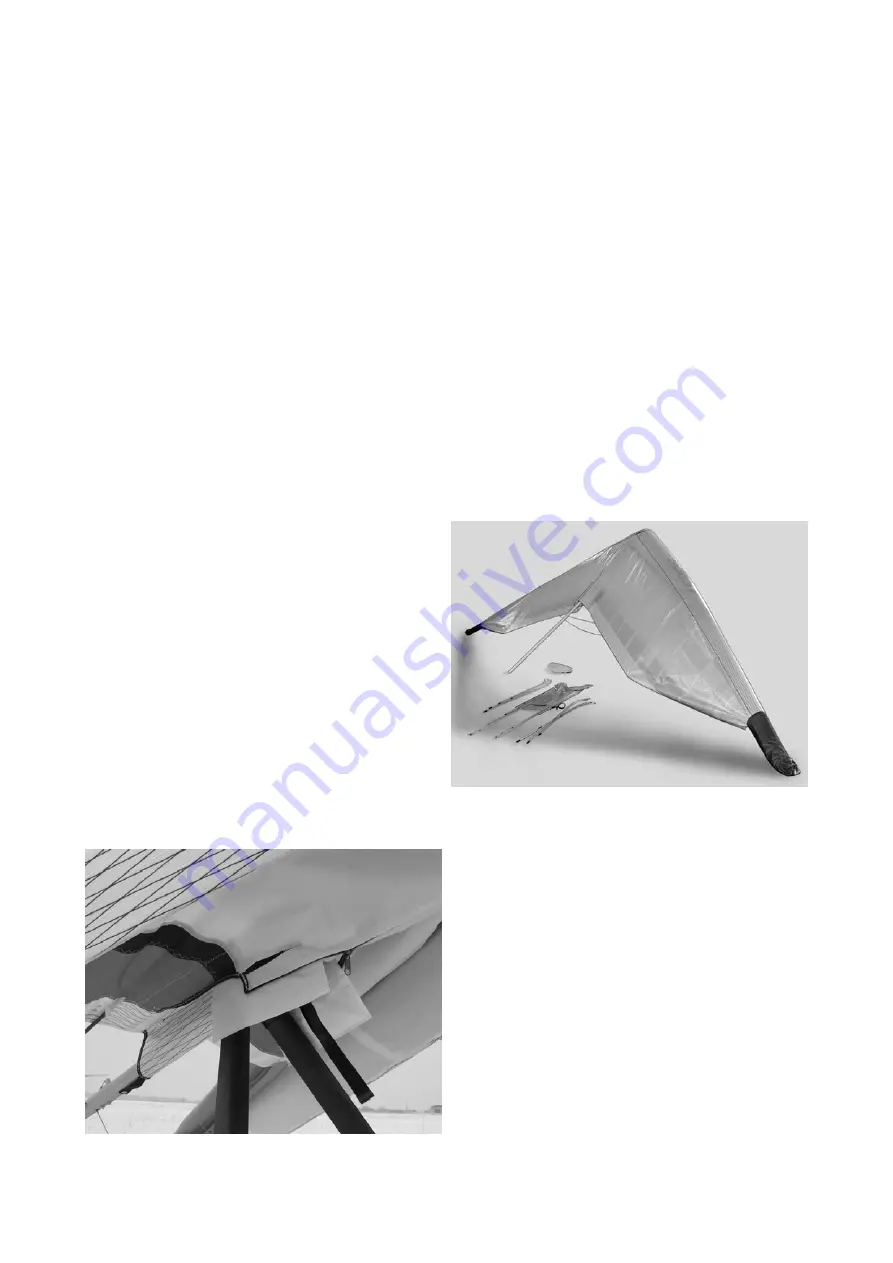
SAFETY IN TURBULANCE
A hang glider is a tailless aircraft and therefore its pitch stability is limited compare to the conventional aircraft. One of
the main design goals of the Combat 09 was to maximize pitch stability with a strong rigid sprog and dive sticks system
and compensated sprog system. After installing the tail on the Combat 09, pitch stability has greatly increased, allowing
even to lower sprogs settings keeping required pitch-up moment. However, there is still remains the risk of a tumble if
extreme turbulence is encountered, and it is important that the pilot understands ways to minimize this risk.
Many tumbles have happened because of the loss of airspeed due to turbulence. When the glider hits the surge of lift,
its nose raises, and even when the pilot holds the control bar in right position, the glider will climb and loose airspeed
quickly – that’s a moment when the tumble can occur, especially if sudden sink or rotating air is encountered. Therefore it
is important to maintain sufficient airspeed in turbulence and quickly react to bring the glider back to a normal flying
attitude, picking up the lost airspeed.
It is very important that the pilot hold the speedbar tight and close to the chest or just below the chest. If sudden
weightless or negative G situation occurs, the pilot should stay as close to speedbar as possible with his chest, keeping
a forward center of gravity, which greatly aids in producing a quick glider recovery.
A loose VG settings, due to the sprog compensator system, produce stronger positive pitch moment at negative angles
than tight VG setting. Therefore, it is necessary to release the VG completely or to ¼ VG when expecting a strong
turbulence. While in turbulence make sure you keep a very firm grip on the speedbar and do not sacrifice this strong grip
to release the VG. It is best to wait for a safe moment and then release.
FLYING IN RAIN
It is strongly advised to avoid flying in rain, as the stall characteristics of the glider change due to rain drops on the
leading edge. If rain is encountered in flight, keep the airspeed well above stall, especially near the ground and avoid any
turns close to the ground. At landing make final approach at higher speed than normally and be ready to flare
aggressively as son as the wing begins to stall. In no circumstances take off when your glider is wet.
COMBAT BREAKDOWN
15
loop out of the slots in bottom surface. Unzip the bottom
battens except the top
bat
ings in parallel to the keel tube.
Take care
tha
Fig.24
Break down of the glider is the reverse of assembly.
1. Start with the VG set full loose. Remove the
nosecone. Remove any instruments.
2. Remove the undersurface battens. Unzip the sprog
access zippers all the way to the leading edge end of the
zippers and put out the inboard and outboard sprogs.
Remove the tip folded battens and the four shortest
battens from the outboard section of the sail. Roll the
outboard section of the sail and put the outboard wing tip
bags on (
Fig.23)
.
3. De-tension the crossbar sweep wire and let the
wings fold in slightly.
4. Open the Velcro behind the hangloop and take the hang
surface central zipper and take the protecting pads sewed on the sail out so that they protect the sail from contact with
the control bar apex fittings (
Fig.24).
Fig. 23
5. Remove the remaining
tens #1. Put the battens into the batten bag.
6. Pull the w
t the shackle of the crossbar sweep wire doesn’t
get caught when entering into the sail!
ires at the nose plate.
7. Detach the front w
Содержание COMBAT-09
Страница 2: ...1...
Страница 27: ...26...
Страница 28: ......
Страница 29: ......
Страница 30: ......
Страница 31: ......
Страница 32: ......
Страница 33: ......
Страница 34: ......
Страница 36: ......
Страница 38: ......
Страница 42: ......
Страница 43: ......
Страница 44: ......
Страница 45: ......
Страница 46: ......
Страница 47: ......
Страница 48: ......
















































